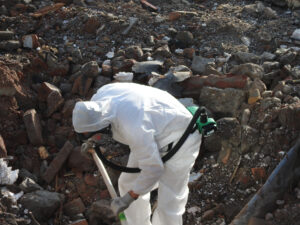Receiving a diagnosis of a severe disease after asbestos exposure in the Coast Guard makes many veterans angry. They want to hold those responsible for the exposure accountable for putting profits over the health of people who honorably served their country. Here’s a look at some of the Coast Guard occupations most closely associated with the Chicago Asbestos Lawyer for veterans suffering from asbestos-related diseases.
Coast Guard Occupations and Asbestos Exposure
Anyone involved in the construction, repair, or maintenance of vessels while in the Coast Guard was at a significant risk of developing an asbestos-related disease. According to a researcher testifying before a US House Committee in 1980, about 50 percent of shipyard workers nationwide had some sort of lung changes due to asbestos exposure. It’s not a stretch to assume the same ratio applies to Coast Guard members who worked on or around ships.
Certain Coast Guard occupations and job roles were at a higher risk of asbestos exposure due to the nature of duties and the environments where the servicemembers operated. Asbestos exposure in the Coast Guard primarily occurred when working aboard ships, conducting maintenance and repair tasks, and handling equipment and materials that may contain asbestos.
Here are some of the Coast Guard occupations most at risk for asbestos exposure:
Boatswain’s Mates
Boatswain’s Mates are crucial in shipboard operations, including deck maintenance and rigging. These duties often involve working near asbestos-containing materials used in ship construction, such as insulation, gaskets, and piping. Boatswain’s Mates may have suffered exposure to asbestos fibers during routine repair, maintenance, and renovation activities aboard Coast Guard vessels.
Machinery Technicians

Machinery Technicians are responsible for operating, maintaining, and repairing mechanical systems and equipment aboard Coast Guard vessels. This includes engines, pumps, hydraulic systems, and other machinery where asbestos components are commonly found, such as gaskets, seals, and insulation.
Machinery Technicians may have encountered asbestos during the inspection, repair, or replacement of these components, especially in older vessels where asbestos-containing materials may still exist. For example, many Coast Guard cutters built before 1991 contained asbestos and lead.
Damage Controlman
Damage Controlman respond to emergencies, including fires, flooding, and other damage aboard ships. As part of their duties, they may work with asbestos-containing materials used in fireproofing, insulation, and protective gear. Damage Control may have suffered exposure from airborne asbestos fibers while extinguishing fires or containing leaks during emergencies.
Electrician’s Mate
Electrician’s Mates are responsible for installing, maintaining, and repairing electrical systems and equipment on Coast Guard vessels. When accessing electrical panels, conduits, or wiring in areas where asbestos materials were present in construction, they may have encountered asbestos insulation or protective barriers.
Hull Maintenance Technician
Hull Maintenance Technicians are skilled in welding, brazing, metalworking, and hull repair and preservation. During their duties, they may come into contact with asbestos-containing materials used in ship construction, such as insulation, adhesives, and coatings. HMTs often inhaled asbestos dust and fibers during welding operations or when removing and replacing damaged hull components.
Firefighter

Coast Guard firefighters are responsible for fire prevention, suppression, and emergency response aboard ships and at Coast Guard facilities. Firefighting equipment and infrastructure may contain asbestos-containing materials, such as insulation, fireproofing, and protective gear. Training exercises, fire drills, or actual firefighting operations may have led to asbestos exposure.
Authorities have made efforts to mitigate asbestos exposure risks in the Coast Guard. However, the legacy of past asbestos use in ship construction and maintenance continues to pose health risks to Coast Guard personnel. Far too many of them have passed away or continue to suffer terribly due to asbestos-related diseases.
The Differences Between Filing a Lawsuit Against an Asbestos Manufacturer and Filing an Asbestos Trust Claim
Veterans who want to hold asbestos manufacturers accountable for causing their illnesses will typically hire an attorney to either sue the manufacturer or pursue compensation from an asbestos trust fund.
While both options aim to provide financial relief to victims of asbestos exposure in the Coast Guard, there are significant differences between the two processes regarding eligibility, timelines, potential payouts, and legal proceedings. Here’s a brief look at each option.
Filing a Lawsuit

Filing a lawsuit against asbestos manufacturers involves initiating legal action against companies that manufacture, distribute, or supply the asbestos-containing products responsible for your exposure. You must hire a personal injury lawyer experienced in asbestos litigation to represent your interests and give you the best chance of achieving a successful outcome.
One key difference between lawsuits and trust claims is the burden of proof. In a lawsuit, you, the plaintiff, must prove the defendant’s liability for your asbestos-related illness. Your attorney must demonstrate your exposure to the defendant’s products and the resulting harm. This often involves presenting documentation, witness testimony, and expert testimony to establish a causal link between the defendant’s conduct and your injuries.
Pursuing Money from an Asbestos Trust Fund
On the other hand, filing a claim with an asbestos trust fund doesn’t require proving fault or liability on the part of any specific manufacturer. Bankrupt asbestos companies established trust funds to compensate victims and avoid lengthy litigation. Trustees usually administer trust fund claims, overseeing funds’ distribution and evaluating claims’ validity.
Timeline Differences
Another distinction between lawsuits and trust claims is the timeline for resolution and potential payouts. Lawsuits can be protracted and may take several years to resolve, particularly if the case goes to trial or is subject to appeals.
On the other hand, trust claims generally have faster processing times, with claimants receiving compensation within months rather than years. However, the compensation available through trust claims may be lower than that obtained through asbestos litigation conferences. The reason is that trust funds often have limited assets to distribute among a large pool of claimants.
Different Legal Proceedings
Lawsuits follow formal court procedures, including filing complaints, discovery, motion practice, and potentially a trial before a judge or jury. Trust claims typically undergo resolution through administrative processes overseen by the trust’s administrators or claims reviewers. While legal representation is essential for both lawsuits and trust claims, the level of involvement and complexity may vary depending on the chosen course of action.
Find Out About How a Mesothelioma Attorney Can Help
Those who suffered asbestos exposure in the Coast Guard deserve every dollar they can get. Contact a skilled lawyer as soon as possible so they can tell you how they can support you and obtain fair compensation.



